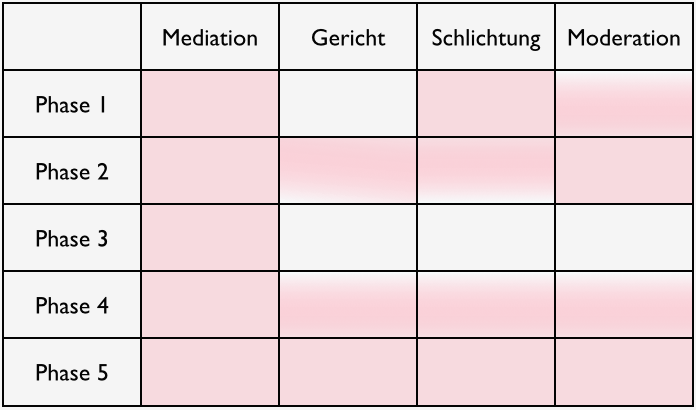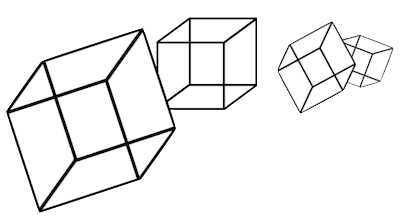Mediating understanding Integrated Mediation
The little German phrase in our claim is: “So verstehen wir uns”. This became a slogan. It cannot be translated properly. There are different connotations possible. The German words at least have a double meaning. One is: “That’s the way how we see ourselves (how we understand us)”; The another one is: “That’s the way how people understand each other”, or maybe even: “That’s the way how people should understand each other!”.
For us, understanding is the focus of mediation. It respects all dimensions of complexity and is connected with the whole person. Body and brain is needed to manage it. Understanding is the source of thinking and thinking is the base for insights. Parties need insights in order to find solutions they didn’t have in mind before.
The problem
Mediation has many faces if you look deeper in it. The common view of western style mediation, based on that Harvard Concept, describes mediation as a more or less straight procedure where the mediator passes the phases more or less mechanically in a frame which makes mediation a formal procedure to be distinguished against court, arbitration conciliation and moderation. This is a limiting view narrowing the scope of mediation. The challenge starts where people have to choose that procedure (though they really do not know what it is) before they start with it. In reality and based on their conflicts people will experience, that this condition is not really natural and in their case it is not given of course. Not because of the party but because of the other side. “Why should I negotiate with somebody who is that stubborn like the opponent? I would but with her or him … No chance! I am tired of that!”. Hence the problem is: mediation could be an appropriate way to find amicable solutions. It will not be demanded as that. People have to choose that procedure before they know why and at a stage where they have difficulties to agree to any proposal from the opponent. Integrated mediation shows the way out of that dilemma. The simple message is:
Just do the mediation. Don't talk about. Mediation will be the outcome
The solution
Today we are able to decline the process in small functional units respecting all the needs and condition needed for them to run. Running together those units substantially realize a mediation the one or other way. Now mediation appears in a much broader scope of options and possibilities, allowed to even happen in a “wrong procedure” with the “wrong roles”. We understood the different views on mediation, why we started to identify our view and insight by the name “integrated mediation”.
The idea behind the word integration mostly is indicated where things should go together. It is reasoned by the need to improve or complete something. Indeed the word ‘integrated’ means “the whole”. Let us see “the whole” (in regard of procedures) as the perfect and complete procedure (when solution finding is the mean), then mediation is equivalent to “the whole”. In that range mediation becomes the benchmark for any kind of processing now. If mediation is a cognition process, it runs in brains mainly. At that place it can be virtualized. Now mediation might be seen like a concept collecting all the elements necessary for finding amicable solutions. Could be seen like an umbrella. It helps steering the process through or into a mediation, which at least is a substantial or a formal one.
Easy to say but how to manage if nobody demands that procedure? The solution will become visible if we understand human behave, humans’ way of thinking triggered in conflicts and if we combine that with the way of thinking triggered through mediation. Again understanding is the key word. Let’s start understanding what integrated mediation means.
What it means?
Surely the term “integrated Mediation” needs to be explained.
History brought that name to us. Many people have in mind that integrated mediation is nothing more but using some mediation techniques outside the mediation process. That’s not enough. Using some techniques in war make it a nice war maybe but it still happens in war. Thus there is more to be enhanced than just using some techniques. Mediation describes all we need.
Our roots go back to the mid of the 90-ies. Arthur Trossen (as a judge), Eberhard Kempf (as a psychotherapist) and Ralf Käppele (as a lawyer), all specialists dealing in highly escalated family conflicts, tried to find ways to release people (and themselves) from those useless conflicts. Mediation became the key.
First trials created the “Altenkirchener Modell“. Altenkirchen is the name of the town and the court where we implemented mediation skills in a contradictory procedure. Opposite to the belief of others it worked, though the judge definitely stuck in the wrong role and the aim of a court procedure is another one. We found methods and strategies to overcome those obstacles step by step. A migration strategy showed how to steer people from confrontation into cooperation. A research by Prof. Dr. Josef Neuert proved a measurable increase of satisfaction for everybody, customers like professionals.
A continuing research taught us more and more about the details behind the functioning of mediation.
How it works?
Just doing mediation, how can that work if mediation is not the demanded procedure?
- The first approach is to see the world from the customer’s point of view. Thus the procedure must fit to the conflict. Fit the form to the fuss is our motto.
- The second approach is to exceed the mediation over its borders by virtualizing the process.
Exceeding the mediation means to understand the different connotations of mediation. In practice and though legal definitions, the word mediation is used in several different meanings. It is quite associative and everybody has his ideas when talking about mediation. “I mediated this conflict”, doesn’t mean that a mediation (in its formal understanding) took place. German law defines mediation as to be a procedure but already in the next section of the law you will find the word mediation-procedure in combination. This doubling wouldn’t be necessary when the term is unique and connoted with one single meaning. Indeed the German law now differs between procedure and methods. The “Güterichter”, who is the judge mediator, is not doing the mediation (in the sense of conducting a formal mediation, where the procedure is called mediation) but he is doing the mediation by using it’s methods. This looks confusing at the first glance. At the second glance we find a systematic behind. It helps dealing with all those different manifestations of mediation. We drafted a plan, where you will find the variety of mediation in a proper order.
The main approach coming out of that is to differ between formal mediation (that is the pure mediation running in an isolated procedure), formal mediation according to the law (that is the pure mediation which is addressed by the law) and substantial mediation (all the other forms where mediation is happening independently from the formal procedure below). What all those different processes and appearances have in common is the idea of mediation realizing the process mediatively.
The key is to understand mediation as a cognition process. A cognition process runs in brains only. This is the chance where we can start dissolving mediation from its chains. We learned to decline this process in sub-processes, that we called functional units. Easy to imagine that small units can be moved and shifted easier into other frames easier than a whole procedure. Let’s assume that those units could appear everywhere in any procedure. Wouldn’t it be obvious that this will improve the proceeding? Wouldn’t it become a substantial mediation, when all the functional units are running together somehow where the sum of them create a mediation again?
Integrated mediation is using those units like puzzle pieces, knowing the pieces needed an at least substantial mediation will be the outcome if those units are going together well. The flexibility becomes possible since we declare the procedures to be nothing more than shucks that we declare to be just containers allowing methods to be used or not. We learned to understand the frames and how to prepare them to incorporate features of mediation.
Where to find it?
Integrated Mediation describes Mediation in all its complexity from different points of view. We are focussing the interfaces as well as anchors for functional units. Taking this into consideration, Integrated Mediation appears in different ways in the landscape of mediation.
Sample application: Combination of precedures to the extend of functional units. Raising of efficiency of proceedings, since repeating phases will be skipped, killer phrases allow turning a negotiation into a mediation, needs will be uncovered and become a leading aspect. Example: It happened that a person wanted to achieve the impossible. She engaged a lawyer. He dismissed when he recognized the behave of that party. She engaged the next one and so on. It’s getting a perpetuum mobile where the process always starts from the scratch. An end is not in view. Now we measure this foregoing with the concept of mediation. The lawyer will ask: Did you already agree to the goal of what the court should achieve? Did you confirm the needs, and so on … Now he can focus those steps that need to be treated more than arguments.
Example to use: During a mediation the depth has to be reduced to an evaluative mediation. The mediator might shift the case to the court also, to add some authority in highly escalated conflicts for example. Everything that is to be seen the motor of the conflict will be involved into the procedure.
Anwendungsbeispiel: Altenkirchener Modell. Mit Hilfe der Migrationsstrategie kann der Sachbearbeiter / Entscheider die Streitparteien in eine Kooperation bewegen. Motive werden indirekt abgefragt. Die Methodik ist in jedem Verfahren (Gericht, Personalentscheidungen) anwendbar und geeignet, diese zu einem konsensualen Ergebnis zu führen.
What’s the benefit?
- For mediators: Understanding the functionality of mediation allows to guide through mediation more secure, more intuitive more detailed and more effective therefore.
- For customers: Customer’s will be leaded to insights where mediation will be the way to go. Mediation becomes available even if it is not liked.
- For professionals: Professionals will be able to use mediation skills (as a substantial mediation) even if they are not in the role of a mediator. This is to improve efficiency and to make it fitting to the customer’s view. This deal is very helpful for judges, lawyers, HR departments, marriage consultants and so on. They can sell the competence of an integrated mediator which will be an USP where mediation services are just an added value if not the procedure of mediation can be sold itself.
- For mediation: The view on mediation becomes more differenced and more scientific. Terms become clearer and the use of mediation will be properly exceeded into other markets where skills are needed more than an increased portfolio of products.
How to get it?
You see, integrated mediation is much more than just a procedure. It describes a way of thinking which will be realized in a substantial mediation. Now you can get services using integrated mediation knowledge by in-mediators. You can lern using it yourself in one of our courses which take place in different countries. You can become a member in one of our associations.







